Exciting New Releases: ZD Toys Collection & Superman Collection
Exciting New Releases: ZD Toys Collection & Superman Collection

Fantastic Four Costumes: From Kirby Classics to MCU-Ready Looks
July 18, 2025 8 min read
When you’ve been saving the world for over six decades, your wardrobe is bound to get a few upgrades — or complete overhauls. And in the case of Marvel’s First Family, that’s exactly what’s happened. Since their debut in 1961, the Fantastic Four have defended Earth (and plenty of alternate realities) through time, space, and dimensions, showing up in hundreds of comics, multiple movies, and even a few animated series.
With such an epic legacy, it’s no surprise that their iconic costumes have evolved with them. Sometimes subtly — as new artists put their spin on the classic blue suits — and other times drastically, reflecting massive story arcs, emotional milestones, or totally different universes. We’ve seen it all: battle-worn suits from tragic timelines, futuristic gear from alternate versions of the team, stylised manga-inspired looks, big-screen reboots, and yes, even some questionable TV variants.
Some costumes were truly fantastic — bold, stylish, and unforgettable. Others… not so much. So we dove into over 50 years of Fantastic Four history to round up 10 of their most memorable looks — and ranked them from "meh" to Marvel-ous.
Fantastic Four's Negative Zone Costumes: A Bold Shift in Issue #256
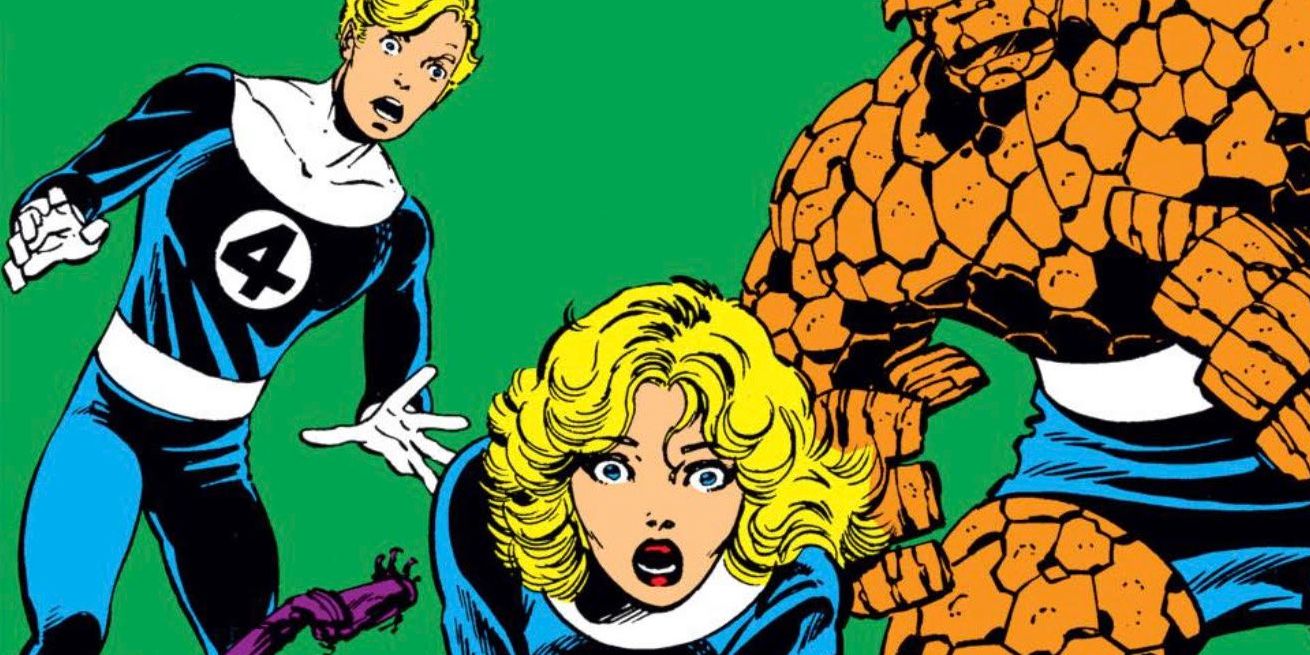
In the Negative Zone, everything is up for grabs — even superhero fashion. In Issue #256 of the original Fantastic Four run, the team faces off against Annihilus, who’s threatening to collapse both the Negative Zone and their own universe with devastating null fields. The climax? A universe-shaking explosion that doesn’t just save reality — it rewrites their wardrobe.
As a result of the near-apocalyptic showdown, the Fantastic Four emerge with drastically altered suits — darkened blues and inverted colors that gave their uniforms a striking “negative” effect. The black turned to white, the blue went deeper and moodier. It marked the first major costume overhaul for the team — and let’s be honest, if you’re going to wait over 250 issues to change up your look, doing it in a dimension-ripping explosion is one seriously bold move.
FANTASTIC FOUR (2005): A Throwback with a Live-Action Twist

Before Chris Evans lit up the MCU as Captain America, he was literally on fire as Johnny Storm in the 2005 Fantastic Four film. While the movie didn’t exactly set the world on fire critically, it did deliver a faithful live-action interpretation of the team’s classic comic book suits.
In the film, the Fantastic Four’s uniforms originate from the very jumpsuits they were wearing during the cosmic accident that gave them their powers — and just like them, the suits evolved. Designed to adapt to each member’s abilities, the costumes function like a responsive second skin.
Stylistically, they stayed pretty true to the source material: black gloves, boots, and collars, with some sleek cinematic upgrades. The “4” logo is shifted to the side, and bold black chevron designs were added across the chest and sleeves — subtle modernizations that grounded the comic look in the real world while keeping the spirit intact.
EARTH'S GREATEST HEROES: A Bold New Look for the Fantastic Four
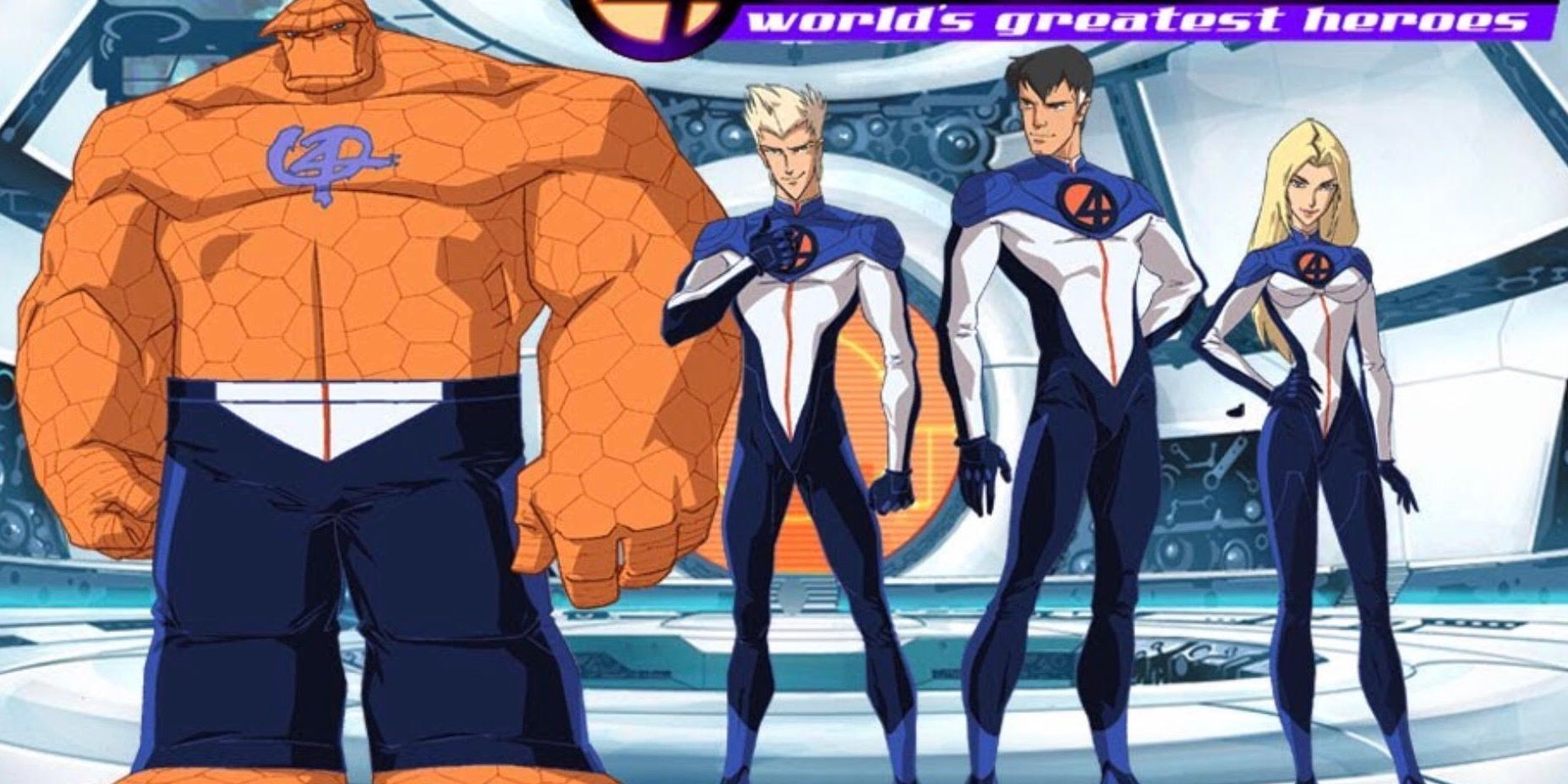
When it comes to animating the Fantastic Four, you'd think their classic blue-and-black suits would be a no-brainer. But the 2006 Cartoon Network series Fantastic Four: Earth's Greatest Heroes had something else in mind. Airing briefly in 2006–2007, and later finding its full audience through reruns on Boomerang, the show took a bold leap in both style and design.
This version of the team sported one of the most unique looks in Fantastic Four history. The costume design broke away from tradition — the upper torso featured a striking white section that came to a sharp point, paired with a darker blue lower half. A slightly different shade of blue highlighted the shoulders and collar, housing the team's signature "4" emblem. Notably, this version of the logo sat on a vivid orange background, with an orange stripe slicing down the center of the uniform for extra flair.
It may not be the classic look, but it certainly made a statement.
FANT4STIC (2015): A Darker Take on the Fantastic Four’s Suits
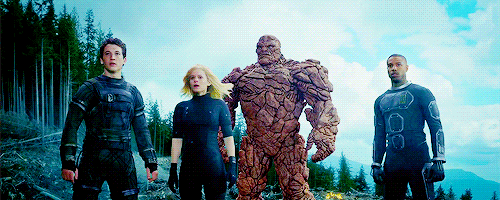
Let’s be honest — the 2015 Fantastic Four reboot didn’t exactly win over fans or critics. But while the film itself may have fizzled, it did introduce one of the most radically reimagined sets of Fantastic Four costumes to date.
These suits weren’t just for style — they were built for survival. Designed as containment gear, each uniform was engineered to help the team manage their volatile new powers, which were unstable and, at times, dangerous. That’s why we see intricate electrical components integrated into each design, with individual suits tailored to control specific abilities.
One of the most surprising departures? There’s no signature “4” logo anywhere on these suits — a deliberate choice, since the team hadn’t yet claimed their name in the film’s timeline. Visually, the all-black, minimalist aesthetic — accented by metal plating — stood in stark contrast to the bright blues and whites traditionally associated with Marvel’s First Family.
HEROES REBORN: The Fantastic Four’s Edgy Counter-Earth Makeover
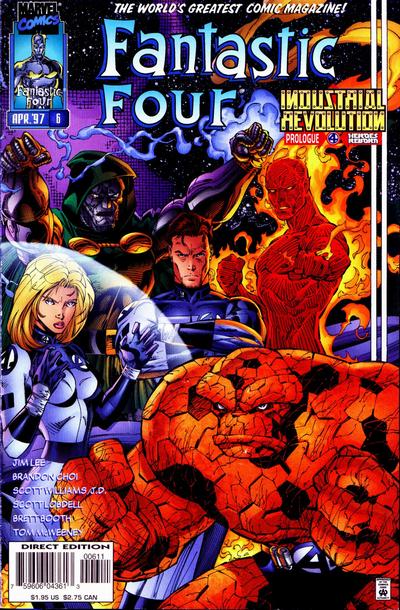
At the explosive climax of Marvel’s Onslaught saga, the Fantastic Four — along with the Avengers — seemingly met their end. But thanks to Franklin Richards’ reality-warping powers, they found themselves reborn on Counter-Earth, a pocket universe where they lived out an alternate timeline far removed from their original reality.
In this new world, the Fantastic Four initially joined forces with Nick Fury, donning S.H.I.E.L.D. uniforms to battle the Sub-Mariner. But in true Sue Storm fashion, she quickly made it clear they weren’t just government agents. She stripped off the S.H.I.E.L.D. patches and slapped on the iconic “4” using tape — a bold, makeshift rebranding that screamed classic Sue and classic ‘90s.
Their suits reflected the gritty aesthetic of the era: mostly gray with bold black accents, utility belts loaded with pouches, and unique wristbands for each member. One arm and leg were blacked out to help form a large stylized “4,” and if that wasn't obvious enough, the emblem appeared in three different places on the uniform.
It was a bold, tactical look for a bold new timeline — raw, reactive, and unmistakably ‘90s.
MARVEL AGE: A Fresh Spin on a Classic Look
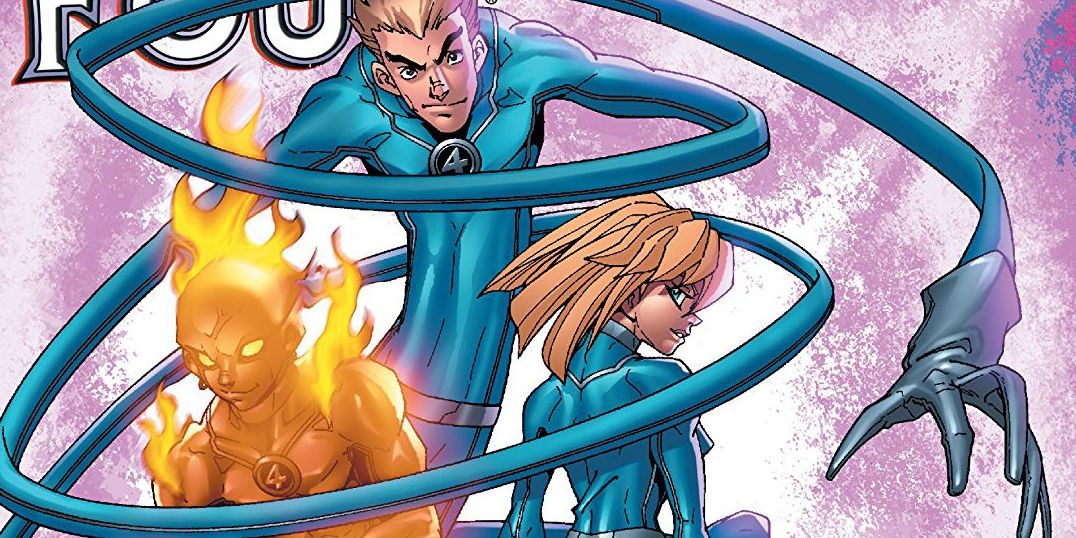
In comics, reboots are practically a rite of passage — and Marvel Age: Fantastic Four embraced that tradition with a fresh take aimed at younger readers. This reimagined series retold the origin and early adventures of Marvel’s First Family in a modern context, and with that came a natural question: what do you do with the iconic suits?
You upgrade them, of course.
The Marvel Age uniforms honored the classic Fantastic Four aesthetic while giving it a cleaner, updated feel. The traditional deep blue was swapped for a lighter shade, and the familiar black accents were replaced with sleek silver. The belts were redesigned with extra detail, the collars trimmed down, and the biggest visual twist — silver stripes running along the sides and linking into the “4” logo — brought a sense of movement and cohesion to the design.
It still felt like the Fantastic Four, just without the '60s timestamp. A modern look for a new generation of fans.
Fantastic Four’s Red and Black Era: A Symbol of Collapse and Change

In 2014, Marvel’s First Family underwent one of their most dramatic transformations — not just in story, but in style. As Fantastic Four relaunched under James Robinson and Leonard Kirk, the team faced internal fractures, external threats, and the looming sense of disintegration. To mirror this turbulent period, the Fantastic Four stepped out in bold, unfamiliar uniforms: black and red.
Gone were the usual blue tones and clean-cut unity. These suits were aggressive and eye-catching — a striking red base with stark black across the upper body and sleeves. The signature "4" emblem was enlarged and placed prominently in the center, and the usual utility belt? Nowhere in sight. The design broke the mold in another way, too: while Reed, Johnny, and Sue typically wear matching suits, this time Sue’s costume inverted the color placement, setting her even further apart — visually and symbolically.
It was a costume shift that didn’t just signal style — it signaled crisis. A falling apart. A visual prophecy of what was to come.
The Fantastic Four in Marvel’s Mangaverse: A Complete Reinvention

In 2002, the Fantastic Four took a dramatic detour into the Mangaverse, and what fans got was unlike anything seen in the mainstream Marvel universe. This wasn't just a costume change — it was a complete reinvention.
The Mangaverse team flipped expectations on their head: Johnny Storm became a woman, Sue Storm turned sociopathic, Ben Grimm looked fully human, and Reed Richards? He didn’t stretch his limbs — just his intellect. And even that required assistance from a high-tech suit.
In this version, the team’s powers weren’t innate; they came from high-powered energy packs on their backs, granting them what were called Megascale Metatalents — abilities loosely inspired by the original FF’s powers but interpreted through a futuristic, mech-anime lens.
Their battle suits were the furthest visual departure from the classic look. In combat mode, each member wore bulky, armored uniforms complete with breastplates, shoulder guards, and glowing tech details. The glowing “4” emblem remained, but now pulsed with energy amidst the mechanical chaos — a symbol that this was still the Fantastic Four… just not the one you knew.
Future Foundation: The Fantastic Four’s Boldest Costume Evolution
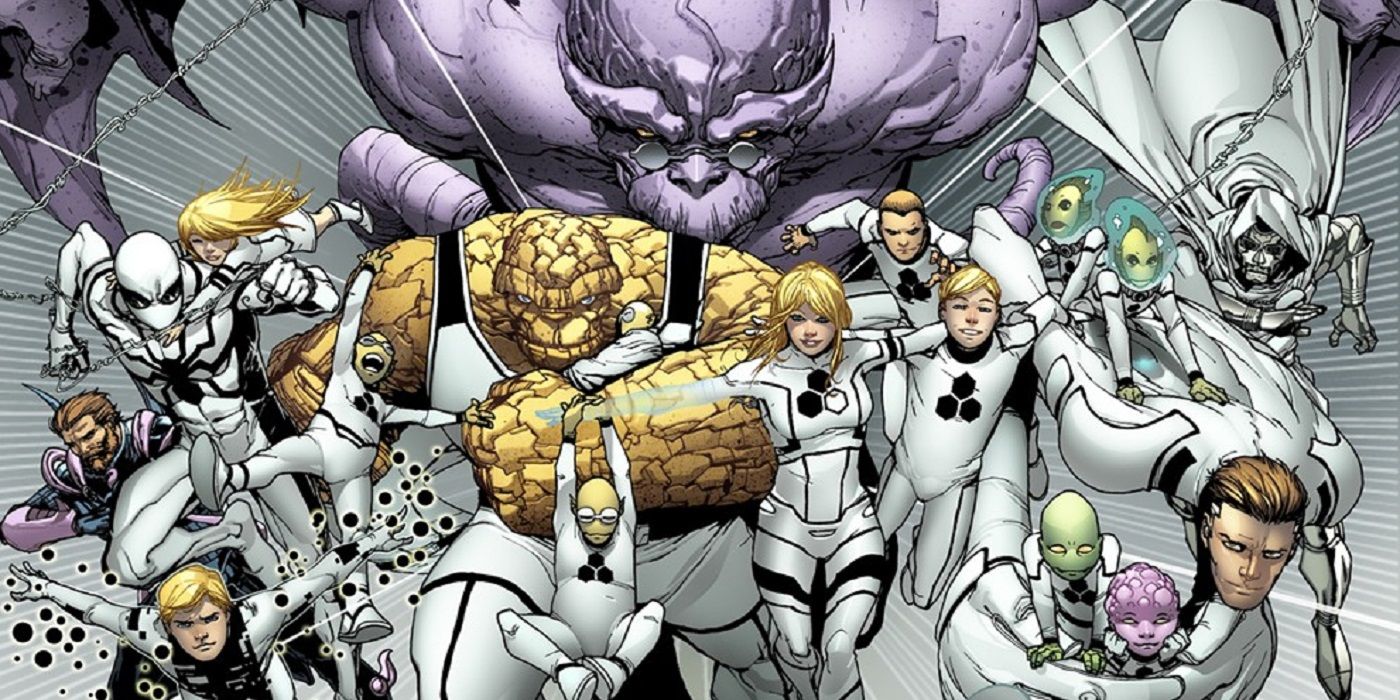
The Future Foundation era marked one of the most profound shifts in the history of the Fantastic Four — both in spirit and style. Sparked by the apparent death of Johnny Storm, who fell in battle against a relentless swarm in the Negative Zone, the team rebranded, refocused, and reemerged with a whole new identity.
No longer the Fantastic Four, they became the Future Foundation — a think tank for the future of mankind. And in a powerful symbolic move, they invited Spider-Man to step in as their fourth member.
Gone were the iconic blue suits. In their place: sleek, white uniforms with stark black accents — a sharp contrast to everything that came before. The familiar "4" emblem was replaced with a bold, hexagonal Future Foundation insignia. It wasn’t just a costume redesign; it was a visual marker of a team in transition — grieving, evolving, and moving forward.
True to comic book tradition, Johnny eventually returned from the dead. When he did, the logo changed back, and the Fantastic Four reclaimed their legacy — but the all-white uniforms? They stayed, a lasting reminder of a moment when the team had to become something entirely new.
Ultimate Fantastic Four: A Modern Redesign of Marvel’s First Family

The Ultimate Fantastic Four series reimagined Marvel’s First Family through a modern lens — younger, edgier, and grounded in a reworked origin. In this Ultimate Universe, the team didn’t get their powers from cosmic rays, but from a catastrophic teleportation accident. The result? A fresh take on familiar characters — and an equally fresh look to match.
This alternate Fantastic Four kept the heart of their classic costumes, but refined the aesthetic with updated lines, tones, and textures. The suits featured two shades of blue, giving them a layered, more dimensional feel. The black accents extended across the shoulders and chest, creating a bold silhouette, and the gloves were redesigned with added detail. The traditional belt? Gone.
The Thing, in a notable change, wore a sleeveless version of the uniform, letting his rocky physique speak for itself. Altogether, it was a thoughtful evolution — a costume that carried the DNA of the original design but filtered through 40 years of updated art and storytelling sensibilities.
Calling all Marvel maniacs and Fantastic Four fans!
Now’s your chance to bring home a piece of superhero history — visit our website today and enjoy up to 40% off on all your favorite collectibles!
Subscribe
Sign up to get the latest on sales, new releases and more …
